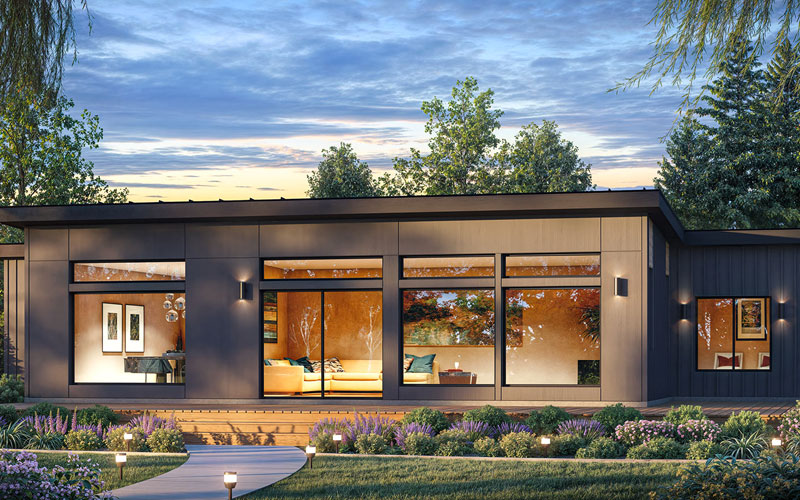Amid rising student loan debt and skyrocketing real estate prices, homeownership is the last thing on most young professional’s minds.
What if you could buy a home for a third of the price of a traditional house, with rental options that have the potential to outpace your mortgage?
Prefabricated homes essentially combine traditional homeownership with technology. They’re typically pre-built through various methods such as 3-D printing before being transported to and assembled at a construction site. Modular homes are another form of prefabricated houses that are at least 70% prefabricated. Though they are placed on a permanent foundation, the structure itself is pre-built and created in sections, making it easy to take apart, transport and build. What’s more, modern-day fabrication technology has caught up to modern-day design, making prefab homes is often not only cheaper than traditional “stick-built” houses, but potentially better looking and more sustainable.
Real estate is still going hot.
After recently looking at homes across six different locations in the U.S., we are looking for a getaway, and we weren’t alone. Spurred by a pandemic-induced great suburban migration, the median house price in the town we settled on was over $2 million; by comparison, the median U.S. home price stands at $270,000. These houses were going well over asking price.
Interest rates are down and money is flowing. This means cheap money is readily available and mortgage rates are the lowest we’ve seen in 50 years. Since the pandemic, some billionaires have increased their wealth by up to 479%, and now along with their shareholders and everyone else with the ability to work during the pandemic, they are buying up hard assets like real estate. When American society is described as a nation divided into two groups, the “haves” and the “have-nots,” we’re talking about asset owners and asset payers. Now may be the time to leverage these mortgage rates, strategically pairing them with tax write-offs and home loans.
Modular housing allows that, but at a discount and with the potential to make money from this investment. Here’s how I saved $2 million-plus by putting my money to work in this niche, but growing market.
Stick-Built Vs. Prefab Construction
I had many questions when I first heard about modular homes. What is their resale value? Is the quality of construction comparable to traditional homes? What loans are available? Here’s what I found.
- Modular homes appreciate/depreciate similar to stick-built, and loans and mortgages are also treated similarly. Not the same for mobile homes that aren’t built on a solid foundation.
- Building and construction currently account for 39% of all carbon emissions in the world, and typically 40% of construction materials end up in landfill.
- Modular homes, on the other hand, are more eco-friendly to build, use less energy while occupied and are easy to recycle and deconstruct at the end of their lifespan. Tax credits are also on the table as they can be recognized as a green form of building.
- Modular construction can last longer than stick-built houses and have been found to withstand winds of up to 180 mph.
- Traditional homes can take four to six months to build. Modular houses may take between six and 10 weeks.
Buy a Home for a Third of the Price
The average property price in our town of interest was $2 million to $3.5 million. By comparison, the average modular price was $600,000 to $1 million. On the lower end, that’s a 33% reduction in property value. So, do you get your money’s worth?
A traditional property came with 1,000-1,300 square feet of space. Modular, on the other hand, offered 2,000-3,000 square feet on a quarter to one acre. The modular design we were interested in had a price point of $900,000 for 3,000 square feet. That comes to about $63 per square foot (this doesn’t include hookups and foundation). On the other hand, the average cost per square foot to build a traditional home comes to $200-$500 per square foot depending on upgrades.
If you’re looking to go modular, your best bet may be to find a developer creating a planned community of modulars as this allows you to utilize a conventional loan.
After a down payment to reserve, you ideally won’t need to pay until the house is fully built and financing options is provided by the developers. Realtors in your local market will be able to pin down modular housing opportunities, which are becoming more and more commonplace.
Building your own modular home also has its benefits as the increase in profit margin will be yours to keep. The catch is that you will likely have to use a building loan (which typically has higher rates of interest) or possibly tap into your mortgage, as conventional loans are not available.
The Future Is Modular
While the concept of factory-built homes may seem strange today, in the next few years, planned modular communities may become much more commonplace. We may be asking not “Who built your house?” but “What factory did it come from?”

